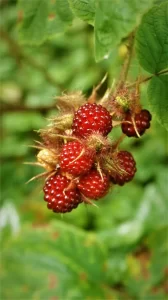What Are Wineberries?
Similar in appearance to its relatives, blackberries and raspberries, wineberries run rampant across much of Virginia. They are easily found in Virginia along roadsides and hiking trails, in thickets and meadows and may already be firmly established on your farm. Also called a wine raspberry, their canes have reddish hairs and small thorns that produce an edible red fruit with a glossy sheen smaller than a raspberry that packs a delicious sweet and tart flavor. Chances are you’ve run across them time and again, possibly without realizing. My kids love to spend hours picking and snacking on them during summer hikes.
Are Wineberries An Invasive Pest Or Summer Treat?
 Wineberries were introduced to North America from Asia at the end of the 19th century to be used as breeding stock for cultivating hybrids with other berries. They have flourished in the wild and are now widespread throughout the Eastern United States being labeled as an invasive species in at least 12 states including Virginia. They reproduce quickly through the spread of the berries through animal droppings as well as by starting new roots when a cane’s tip droops and touches the ground. However the delicious flavor of the berries make them sought after seasonal delicacies in farmers’ markets and as an ingredient for all sorts of delectable dishes.
Wineberries were introduced to North America from Asia at the end of the 19th century to be used as breeding stock for cultivating hybrids with other berries. They have flourished in the wild and are now widespread throughout the Eastern United States being labeled as an invasive species in at least 12 states including Virginia. They reproduce quickly through the spread of the berries through animal droppings as well as by starting new roots when a cane’s tip droops and touches the ground. However the delicious flavor of the berries make them sought after seasonal delicacies in farmers’ markets and as an ingredient for all sorts of delectable dishes.
Picking, Storing and Eating Wineberries
As wineberries ripen they darken to a bright red. They will often start to pull away from the conical stems making the ripest (and sweetest) ones drop off of the plant with a slight touch. Less ripe (more tart) berries may require a very gentle pull but if you have to give them a tug chances are they aren’t at their tastiest yet. Be gentle as they crush very easily.
Their fragile nature and speedy ripening presents a bit of a challenge for storing as they have a very short shelf-life when fresh. Eat the picked fruit quickly and don’t over stack them or you may end up with a mushy mess. For longer storage, lay them out in a single layer spaced on a sheet pan to freeze them then transfer to a freezer bag to keep these goodies available long after the picking season ends.
Wineberries have endless uses in the kitchen if you can resist the temptation to simply eat them all right off of the plant. Fresh berries make a great topping for cereal and yogurt or as a beautiful garnish for desserts and parfaits. Try pureeing them with a touch of lemon zest and confectioners sugar for an amazing sauce to drizzle over a chocolate torte or cheesecake (though you may want to strain out the seeds with cheesecloth first). Muffins and pancake mixes are also very friendly with wineberries but frozen berries are preferable here to avoid breaking them prematurely. Making jam is also a fun way to preserve extra fruit and will be sure to knock the socks off of your favorite PB&J lover or enhance an English muffin (again, you may want to strain out the seeds).
Controlling Spread And Removing Wineberries From Your Property
Controlling the spread of wineberries is important. As an invasive species, they are able to spread relatively quickly forming dense thickets that can threaten natural ecosystems as well as agricultural areas by outcompeting native or propagated plant life if not kept in check . For this reason wineberry plants are illegal to grow or sell in states such as Connecticut and New York. Undesirable plants can be removed by digging out the root system. Most of the plant material can be composted however berry bearing stems should be bagged and disposed of. Repeated cutting or mowing can also kill wineberries. Alternatively, some herbicides such as glyphosate can be applied to the leaves as a method of control. As always, make sure to follow manufacturer’s recommendations for dosing concentrations, application and safety precautions when using any herbicide.
